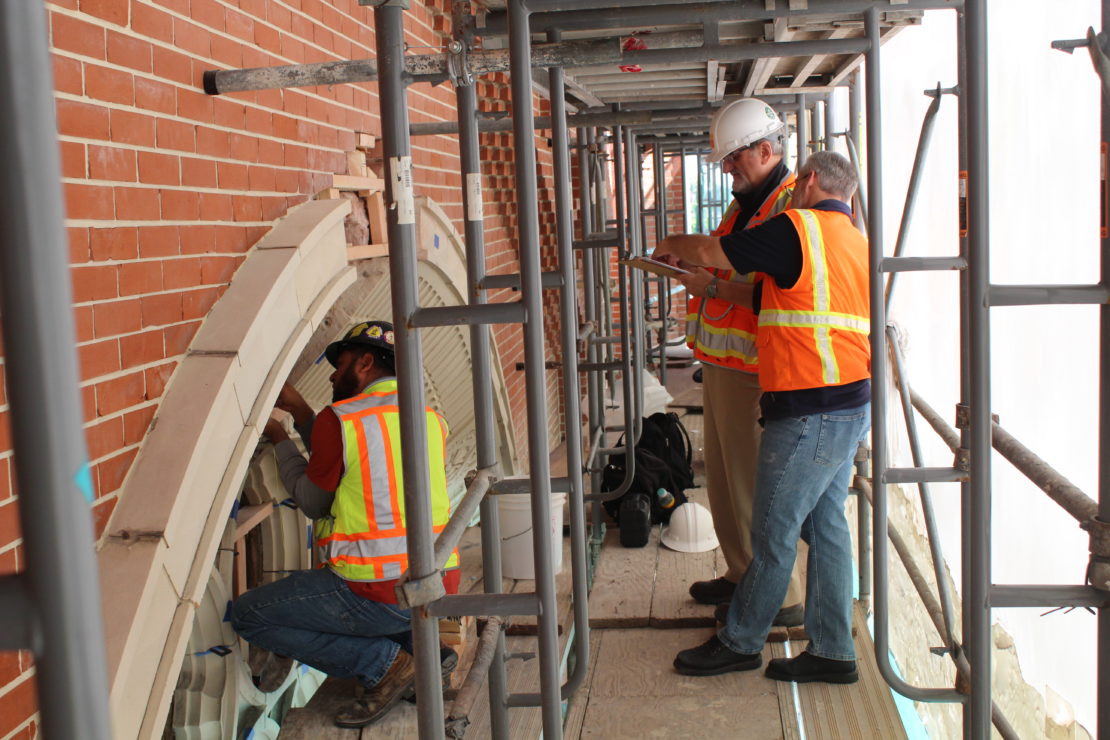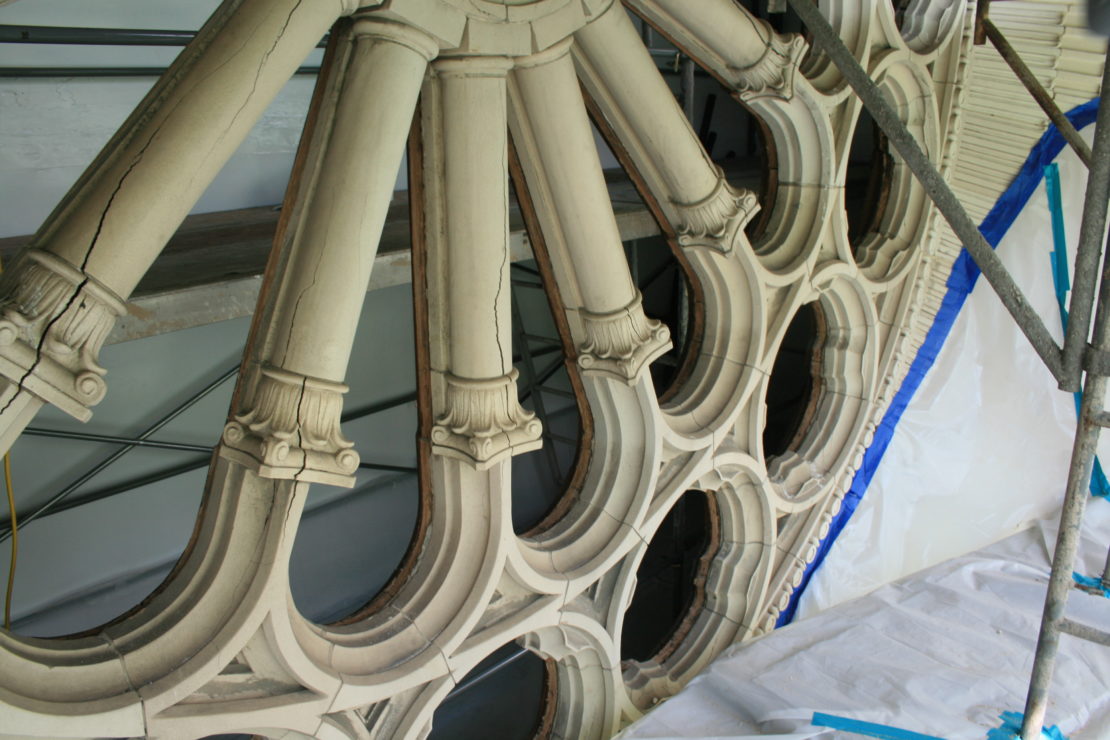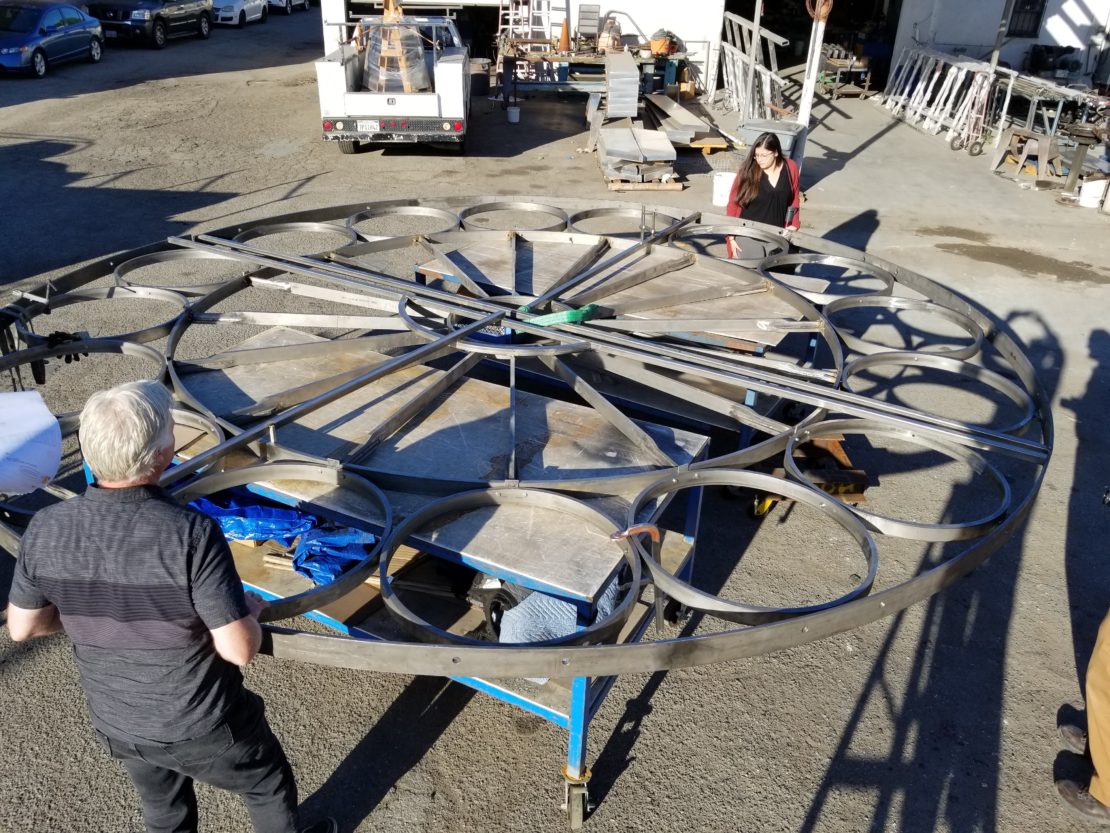Long Beach’s landmark First Congregational Church (United Church of Christ) has seen better days, but to be fair, it’s seen a lot of days since it was built in 1914. Time, the elements, earthquakes, the salt air from the nearby Pacific, a few dicey construction miscues, they’ve all taken their shots at the building on Third Street and Cedar Avenue in Downtown.
And yes, the wondrous Italian Romanesque Revival structure is showing its age. It is still a solid house of worship, with a beautiful sanctuary that’s full of elegant woodwork, a hugely majestic and sometimes deafeningly loud pipe organ and serene lighting that pours in from its stained-glass rose windows that bring in morning light from east and north.
To forestall the enemy that is time from doing further damage, the church has embarked on an ambitious renovation and restoration project to repair damages to the church’s eastern side: chiefly damaged brickwork, crumbling decorative terra cotta and the imperiled rose window.
Overseeing the renovation is John Fidler, the president and chief technical officer of John Fidler Preservation Technology in Marina del Rey.
“We’re only doing 50 percent of the work that needs to be done,” said Fidler. “We’re concentrating on the eastern facade along Cedar; there’s not enough money to do the north side, though the damage is about the same.”
Fidler’s team includes an engineer and an assistant, two architects, a facade engineer and himself, as well as Giampolini and Co. Construction, based out of Emeryville, to work under Fidler’s guidance.

The initial $1.65 million project, says Fidler, “is a big investment for a congregation,” and, with the help of some grants, including a $100,000 matching grant from the National Trust’s Partners for Sacred Places, the proposal for the restoration has been expanded to focus on the church’s deteriorating brickwork.
Restoration of historic buildings is an exacting process in terms of matching new materials to historic ones. First Congregational’s architect in 1914 was H.M. Patterson, who designed dozens of churches, mostly Presbyterian, in Southern California, including the historic First Presbyterian Church of Hollywood. For Long Beach, Fidler says, “Patterson chose a rather soft brick for the facades because he wanted a mellower look. He used bricks from L.A. Pressed Brick and Terra Cotta Co., and that business closed, but we found a company that uses the same clay fields.”
Patterson was also one of the first architects to use water repellent to protect the bricks, but, unfortunately, it had the opposite effect.
“It’s almost impossible to get perfect covering, so there’s ways for the water to creep in and with salt water, the salt can’t escape and it builds up and corrosion occurs.”
So Fidler’s team is looking at the eastern side of the church brick-by-brick and has found about 5,000 that need to be replaced.
The big project for the restoration team, though, is the eastern rose window. Seventeen feet in diameter, the window features 16 petal-shaped spokes outlined by white terra cotta.


“It’s typical of these kinds of restoration programs where someone has a little bit of money to take care of the stained glass, then the glass guys say you’ve got cracks in the terra cotta, and then you’ve got to replace the terra cotta with some that’s the right color.”
To find that, Fidler, who is British, contracted with a firm in England that could reproduce the decorative terra cotta that, he said, was made in New Jersey by Atlantic Terra Cotta Co., in Perth Amboy. Again, long out of business. “There are now only about three or four firms worldwide that could make the match,” said Fidler. “We spent a lot of time getting the color right.”

There were plenty of other “surprises,” he said, in the course of taking things apart: Rust, rotting wood, crumbling mortar, lead paint and asbestos, issues from the building settling over the decades. They are or will be dealt with. Fidler said the project is about halfway finished, with completion expected in April.
“To be fair to the church, they thought all the big stuff was taken care of in the 1980s when they retrofitted the church.” That, too, was an ambitious $2.5 million undertaking that, while it didn’t deal directly with aesthetics, resulted in a sturdier structure.
“The building is not going to collapse,” Fidler said. “It’s a very robust building from that aspect. But this is the oldest church in Long Beach and it deserves care and attention. The congregation loves this building; they see it as part of their extended community.”
The restoration project, he says, is a giant undertaking for the small but buoyant congregation, which continues to seek funding for the project and its ever-increasing problematic discoveries.
Fidler will give a presentation of the First Congregational restoration project on Nov. 10 at the church, 241 Cedar Ave. Brief tours of the church will begin at 11:30 a.m., followed by the presentation from noon to 1:30 p.m. The event is free (donations will be gratefully accepted) and reservations are recommended at LBHeritage.org.

